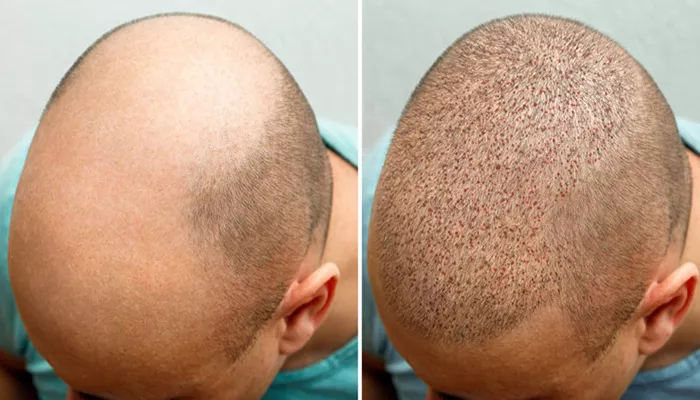A hair transplant is a surgical procedure. It involves moving hair follicles from one part of the body to another. Typically, hair is taken from the back or sides of the scalp. This area is called the donor site. The hair is then transplanted to thinning or balding areas, known as the recipient site.
Understanding Hair Transplant Basics
Types of Hair Transplants
There are two main types of hair transplant procedures: Follicular Unit Transplantation (FUT) and Follicular Unit Extraction (FUE).
Follicular Unit Transplantation (FUT)
In FUT, a strip of scalp with hair is removed. This strip is usually taken from the back of the head. The strip is then divided into smaller units. These units contain a few hair follicles each. The units are transplanted to the balding areas.
Follicular Unit Extraction (FUE)
In FUE, individual hair follicles are extracted. They are taken directly from the donor site. These follicles are then implanted into the recipient site. FUE leaves tiny scars. These scars are less noticeable than the linear scar from FUT.
Growth Phases After a Hair Transplant
After a hair transplant, hair goes through several phases of growth. Understanding these phases can help manage expectations.
Immediate Post-Transplant Phase
Right after the surgery, the scalp will be sensitive. There will be scabs and redness. These will heal in a few weeks. The transplanted hair may fall out within the first few weeks. This is a normal part of the process. It is called shock loss.
Resting Phase
After the initial shedding, the hair enters a resting phase. This phase can last for a few months. During this time, there may be little to no visible hair growth.
Growth Phase
After the resting phase, the transplanted hair begins to grow. This typically starts three to four months post-surgery. Hair growth continues and becomes more noticeable over the next six to twelve months.
Factors Affecting Hair Growth After Transplant
Several factors influence the growth of hair after a transplant. Understanding these can help in achieving the best results.
Quality of Donor Hair
The quality and quantity of donor hair play a crucial role. Healthy, strong hair from the donor site leads to better transplant results.
Surgeon’s Expertise
The skill and experience of the surgeon are vital. An experienced surgeon can ensure proper placement and density of transplanted hair.
Post-Operative Care
Following the surgeon’s post-operative care instructions is essential. Proper care prevents infections and ensures better growth.
Overall Health
The patient’s overall health affects hair growth. A healthy lifestyle, good nutrition, and avoiding smoking can enhance hair growth.
Can You Grow Your Hair Long After a Hair Transplant?
Yes, it is possible to grow your hair long after a hair transplant. However, it requires patience and proper care. The transplanted hair will initially grow in short. Over time, it will lengthen and can be grown to the desired length.
Managing Expectations
It is essential to manage expectations realistically. Hair growth after a transplant is gradual. Full results can take up to a year or more to become apparent.
Initial Length
In the first few months, the transplanted hair will be short. This is normal and expected.
Growth Rate
Hair typically grows at a rate of about half an inch per month. The transplanted hair follows this growth rate.
SEE ALSO: Does Hair Transplant Cause Brain Tumor?
Styling Long Hair After Transplant
Once the hair has grown to a sufficient length, it can be styled. There are some considerations to keep in mind when styling long hair post-transplant.
Gentle Handling
Transplanted hair should be handled gently. Avoid excessive pulling or tight hairstyles.
Use of Products
Use mild, sulfate-free shampoos and conditioners. Avoid harsh chemicals that can damage the hair.
Heat Styling
Limit the use of heat styling tools. If necessary, use a heat protectant spray.
Regular Trims
Regular trims can help maintain the health of the hair. Trimming prevents split ends and keeps the hair looking neat.
Diet and Nutrition for Healthy Hair Growth
A balanced diet and proper nutrition are essential for healthy hair growth. Certain vitamins and minerals play a crucial role in hair health.
Protein
Hair is made of keratin, a type of protein. Ensure adequate protein intake from sources like eggs, fish, and lean meats.
Vitamins
Vitamins A, C, D, and E are essential for hair health. These vitamins promote hair growth and prevent hair loss.
Minerals
Minerals like iron, zinc, and magnesium are vital for hair health. They support hair growth and strength.
Hydration
Staying hydrated is crucial for overall health, including hair health. Drink plenty of water daily.
Supplements
In some cases, supplements can help. Biotin, omega-3 fatty acids, and other hair growth supplements can be beneficial.
Conclusion
Growing your hair long after a hair transplant is achievable. It requires patience, proper care, and a healthy lifestyle. Understanding the growth phases and managing expectations are key. With time and care, you can enjoy long, healthy hair post-transplant. Always consult with your surgeon for personalized advice and follow their recommendations for the best results.
FAQs
Will the Transplanted Hair Fall Out Again?
The transplanted hair is resistant to the hormone that causes balding. It is usually permanent. However, it is essential to continue caring for the hair.
Can Transplanted Hair Be Colored?
Yes, transplanted hair can be colored. It is advisable to wait a few months post-surgery before coloring. Always consult with your surgeon before making changes.
Is There a Risk of Infection?
Like any surgical procedure, there is a risk of infection. Following post-operative care instructions minimizes this risk.
How Soon Can I Resume Normal Activities?
Most patients can resume normal activities within a week. However, avoid strenuous activities for a few weeks.
Do I Need Multiple Transplants?
In some cases, multiple sessions may be required. This depends on the extent of hair loss and the desired density.

